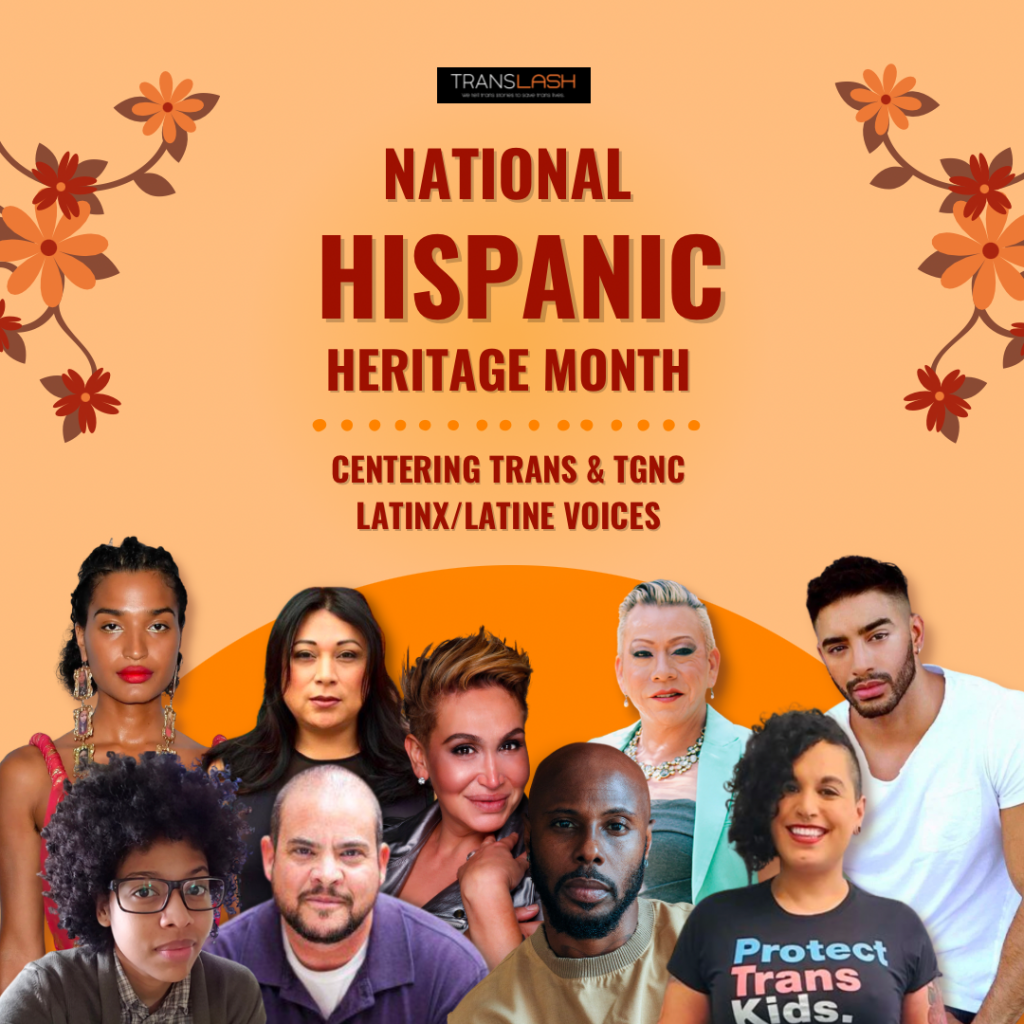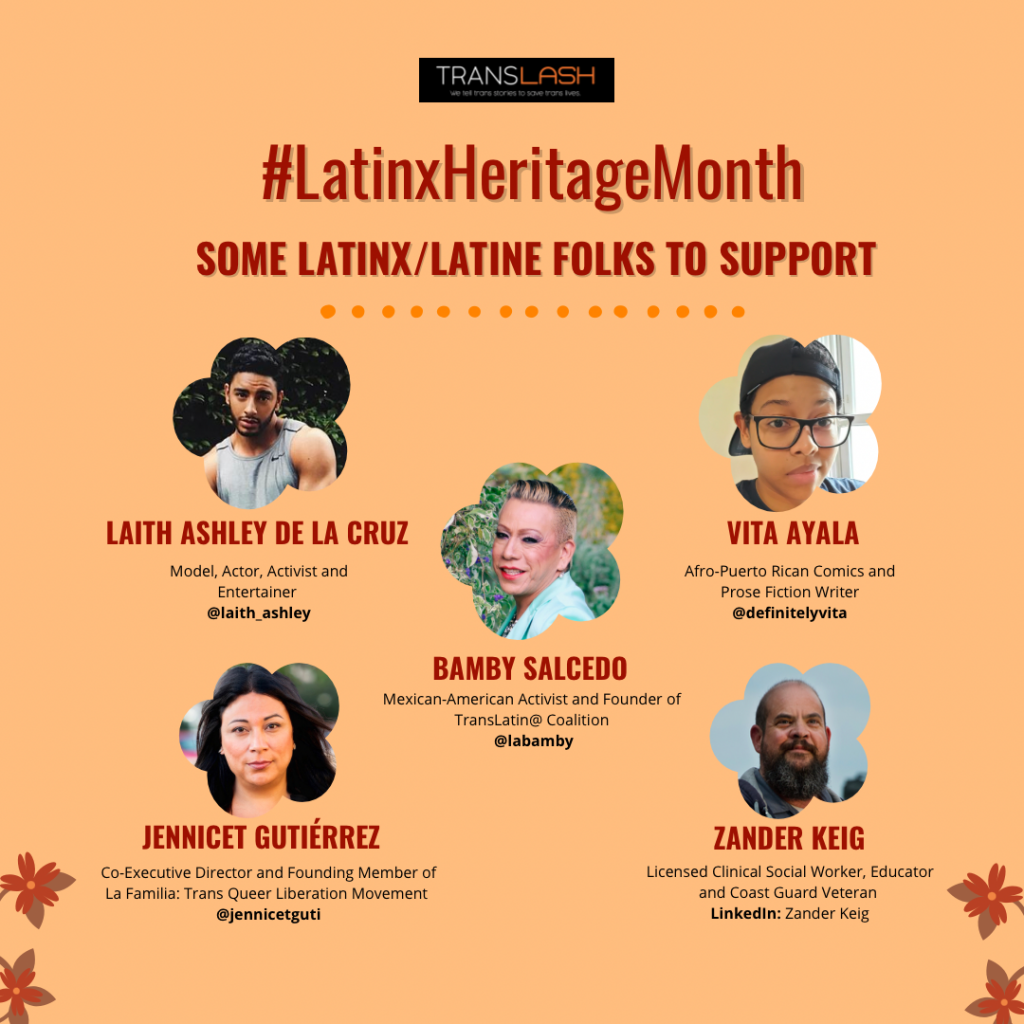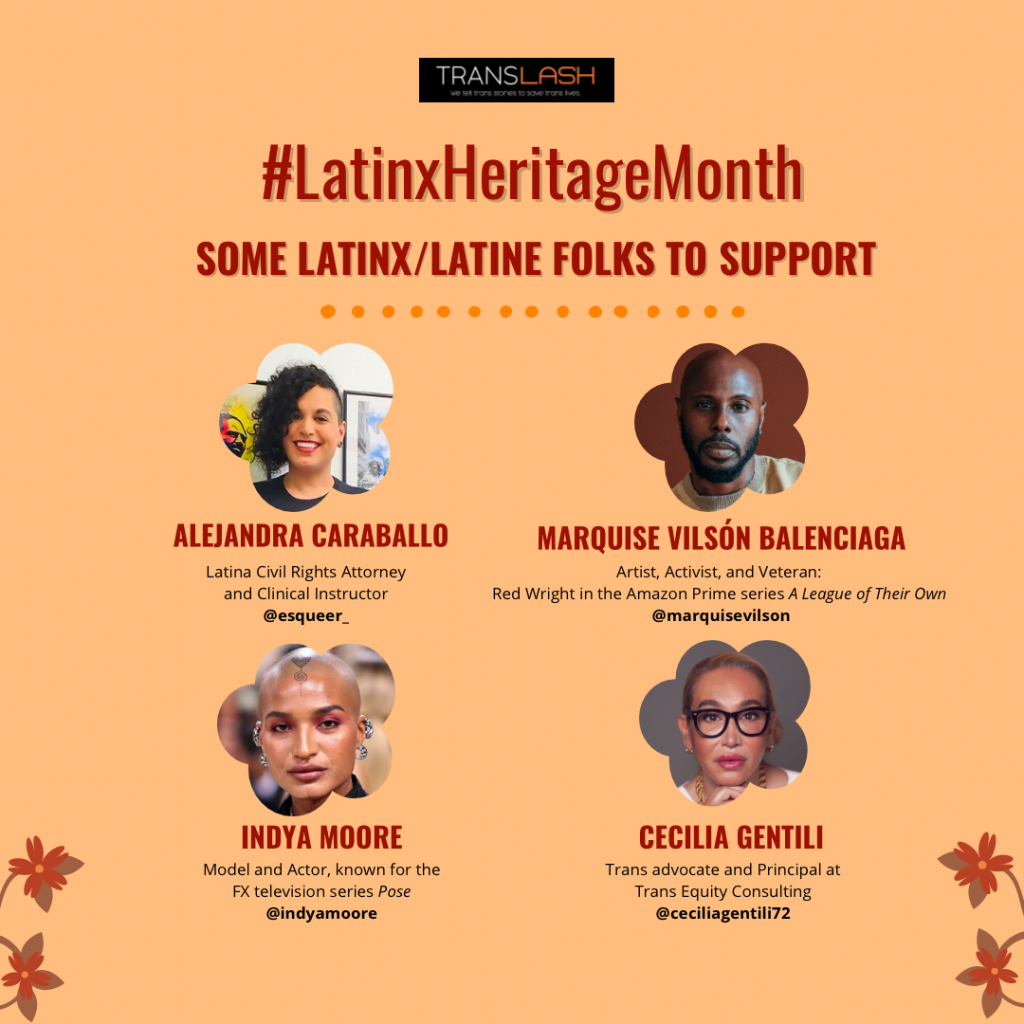By Daniela “Dani” Capistrano for TransLash Media (They/Them/She)
National Hispanic Heritage Month can elicit the entire spectrum of human emotions for our Latinx/Latine trans and TGNC siblings—and we’re holding space for that complexity! Whether you refer to September as Latinx Heritage Month or National Hispanic Heritage Month, we hope you find this trans-affirming guide useful as you explore what Hispanic means.

Where Did ‘Hispanic’ Come From?
It’s important to remember that Hispanic is not a race; it is a United States government demographic category that over time was incorrectly interpreted by white people, Latino/Latinx/Latine people, and other races as a racial category. There are also some Latino/Latinx/Latine trans and cisgender people who don’t personally identify as Hispanic at all—and that is valid. Hispanic is a made up word, in the ways that all words are made up—but with a clear political agenda:
In 1977 the U.S. Federal Office of Management and Budget (OMB) created Directive No. 15, which defined Hispanic as “a person of Mexican, Puerto Rican, Cuban, Central America or South America or other Spanish culture or origin, regardless of race.”
Cristina Mora, a sociologist at the University of California, Berkeley, wrote about the adoption of the term Hispanic in Making Hispanics: How Activists, Bureaucrats, and Media Created a New American. Mora found that use of the umbrella categorization is inextricably linked to the U.S. Census and its attempts to identify and quantify different groups of people.
The United States government created “Hispanic” in collaboration with Mexican-American political elites to normalize cultural assimilation into American society among all “Hispanic/Latino” people. The United States government and these elites wanted to suppress the anti-assimilationist politics of Chicano identity, which had gained prominence through the Chicano Movement—a Mexican-American movement (heavily influenced by the Black Panther Party) that advocated social and political empowerment through a chicanismo or cultural nationalism.
Hispanic was formally codified by the OMB in 1977, but according to NPR, The Pew Research Center reports that in the 1930s Latinos living in the U.S., regardless of their place of birth or family origin, were all noted as “Mexican” by door-to-door U.S. Census Bureau counters—even if they weren’t from Mexico. It wasn’t until 1970 that the agency began asking Latinos living in the U.S. to self-identify as either “Mexican, Puerto Rican, Cuban, Central or South American, Other Spanish” or “No, none of these.”
Since not every Spanish speaking person in the USA in the 1970s was Mexican-American, or even agreed with the Chicano Movement, the OMB was successful in quickly normalizing the term Hispanic.
The Difference Between ‘Hispanic’ And ‘Latino’
It wasn’t until 2000 that the U.S. Census included Latino along with Hispanic. As a result, it’s not uncommon for Latino/Latinx/Latine people and their family members to use the terms Hispanic and Latino interchangeably, but they have different meanings:
Hispanic usually refers to people with ancestry from/in a Spanish-speaking country, while Latino is typically used to identify people who hail from Latin America. Hispanics and Latinos can be a mix of racial backgrounds, including white, Black, and asian.
However, a person from Spain can be Hispanic but not Latino/Latinx/Latine; Spain is a Spanish speaking country but not a Latin-American country. A person who is Latino may also be Hispanic, or not.
An added layer of complexity: there are generations of Latino/Latinx/Latine people born in the United States since 1977 who don’t speak Spanish at all, but were raised by their Spanish-speaking Hispanic and/or Latino/Latinx/Latine parents to identify their race as Hispanic—even though Hispanic is not a race.
Hispanic, Latino, Latinx, and Latine are not racial categories. Anyone of any race can fall into these categories.
While these generations Latino/Latinx/Latine folks may not speak Spanish like their parents or Spanish speaking guardians, this doesn’t make them any less “Hispanic/Latino” in the eyes of the government, or in news coverage of Hispanic communities.
The consequence is that some Spanish speaking people (or people raised by Spanish speaking parents/relatives/guardians) in the United States may not personally identify as Hispanic, but the forms they complete throughout their lives will require them to do so if they want to access resources.
Why Do Some People Consider ‘Hispanic’ To Be Problematic?
With much controversy, Hispanic has become a default umbrella term used in popular culture to define “Spanish speaking people” in America—even when the person may not speak Spanish at all.
For many Latinx/Latine people (cisgender, trans, and TGNC), Hispanic is strictly a reductive term that causes harm—one that treats people of Latin American and/or Spanish ancestry as a monolith that is more digestible; a convenient way for the United States government to reduce the nuanced experiences of many people from 30+ different countries into one apolitical trope, while erasing the existence of Aro-Latinos around the world.
According to Quartz, Geraldo Cadava, an associate professor of history and Hispanic studies at Northwestern University, claims that “terms like Hispanic and Latino do not fully capture how we see ourselves.”
María R. Scharrón-del Río, a psychologist and an associate dean of education at Brooklyn College, co-wrote Latinx: Inclusive Language As Liberation Praxis. Scharrón-del Río identifies herself as queer. “Language is an intervention tool, said Scharrón-del Río to NPR, “it saves lives.” They said that using the right pronouns and the right names has a positive impact on people. Scharrón-del Río explained that Latinx often “creates discomfort” in some settings, because it is a term that reclaims the history of LGBTQIA Latinx people who have been overlooked and neglected.
So if Hispanic is such a toxic term, why do many people of Latin American and Spanish ancestry (cisgender, trans, and TGNC) continue to use it?
‘Hispanic’: A Double-Edged Sword
Just because a Latino/Latinx/Latine person checks the Hispanic box on a job, college, or loan application doesn’t mean that they have a personal connection to the term. For many people, the usage of Hispanic and its function as a gatekeeping classification means that we’ve had a complicated, lifelong relationship with the term.
In 2022, it’s still rare that a form collecting demographic data will include all Latin American and Spanish speaking countries—and even more rare to acknowledge the existence of Afro-Latinos and trans and TGNC people of Latin American ancestry.
As Juliana Martínez, author and assistant professor at American University, explains, “Latinx” is a newer term that has recently gained popularity among scholars, activists and millennials that is inclusive of gender-expansive and gender non-conforming individualsl.
Additionally, Latinx and Latine challenge the binary nature of the Spanish-language term Latino(a). The powerful “X” has opened the door to a variety of identities, and it is also used in the term “Chicanx(o/a)” to highlight the broad indigenous heritage of many groups.
It’s no surprise that a study by the Pew Research Center revealed that the majority (51%) of people classified as Hispanic prefer to identify with their families’ country of origin or nationality, while only 24% prefer the terms Hispanic or Latino.
The choice between the terms is frequently associated with location: people in the eastern United States tend to prefer Hispanic, whereas those in the west tend to prefer Latino.
Outside of the United States, people living in Latin American countries usually refer to themselves by the names of their countries of origin. This is why many Spanish speaking immigrants in the United States have no connection to the term Hispanic but will use it simply to navigate systems of oppression, and why some white Hispanics bristle at being identified as white despite Hispanic not being a racial category.
What Is The Difference Between National Hispanic Heritage Month and Latinx Heritage Month?
The United States observes National Hispanic Heritage Month from September 15 to October 15, by “celebrating the histories, cultures and contributions of American citizens whose ancestors came from Spain, Mexico, the Caribbean and Central and South America.”
The observation started in 1968 as Hispanic Heritage Week under President Lyndon Johnson and was expanded by President Ronald Reagan in 1988.
September 15 is significant because it is the anniversary of independence for Latin American countries Costa Rica, El Salvador, Guatemala, Honduras and Nicaragua. Mexico and Chile celebrate their independence days on September 16 and 18. Source: hispanicheritagemonth.gov
Since Hispanic isn’t a race, Hispanic Heritage Month is really about celebrating our diverse cultures. People of Latin-American and Spanish ancestry usually process Hispanic Heritage Month through the lens of their generational influences. Boomers tend to embrace the term Hispanic, while some younger millennials and Gen Z are turned off by its white supremacist origins and prefer to use Latinx Heritage Month.
Supporting Latinx/Latine People During Hispanic Heritage Month
In the mix of all of this Hispanic Heritage Month discourse, Latinx/Latine folks (trans and TGNC people of Latin-American and Spanish ancestry) are a valid part of the month’s acknowledgements and celebrations.
While the origins of Hispanic Heritage Month aren’t rooted in a fight for trans rights, it has become a month during which trans and TGNC people of Latin-American and Spanish ancestry (Latinx/Latine) can come together to share their stories—and push for awareness about why it’s transphobic to accept Hispanic and Latino as valid terms but not Latinx/Latine to describe people of Latin-American and Spanish ancestry.
Some trans and TGNC Latinx/Latine people choose to only refer to the month of September as Latinx Heritage Month to uplift trans and TGNC Latinx/Latine people, while others still refer to the month as National Hispanic Heritage Month.
Latinx and Latine are necessary terms to affirm trans and TGNC people of Latin-American and Spanish ancestry during the month of September and beyond, which means that it’s valid that National Hispanic Heritage Month and Latinx Heritage Month continue to be used interchangeably.
Wherever you are on your journey as a trans and TGNC person of Latin-Amercan and/or Spanish ancestry, Team TransLash sees you!
Some Latinx/Latine Leaders To Support On Instagram

Follow these amazing Latinx/Latine and Afro-Latinx people on Instagram!
Vita Ayala
Afro-Puerto Rican Comics and Prose Fiction Writer
Alejandra Caraballo
Latina Civil Rights Attorney and Clinical Instructor
Laith Ashley De La Cruz
Model, Actor, Activist, and Entertainer
Cecilia Gentili
Trans advocate and Principal at Trans Equity Consulting
Jennicet Gutierrez
Co-Executive Director and Founding Member of La Familia: Trans Queer Liberation Movement
Zander Keig
Licensed Clinical Social Worker, Educator, and Coast Guard Veteran
Website: www.zanderkeig.net
Indya Moore
Model and Actor, known for the FX television series Pose
Bamby Salcedo
Mexican-American Activist and Founder of TransLatin@ Coalition
Marquise Vilson Balenciaga
Artist, Activist, and Veteran: Red Wright in the Amazon Prime Series A League of Their Own

More Latinx/Latine Resources
- We interviewed two non-binary people for Latinx and Hispanic Heritage month to get their thoughts on bodily autonomy, their role models, and how the TGNC community can do a better job of supporting Latinx and Hispanic people in our circles.
- In the Shadow of the Health-Care City: Historicizing Trans Latinx Immigrant Experiences during the Coronavirus Pandemic
- Trans-Affirming Guide to Latinx Heritage Month (2021)
- TransLash Podcast: Latinx Heritage Month (2021)
Did you find this resource helpful? Consider supporting TransLash today with a tax-deductible donation.


